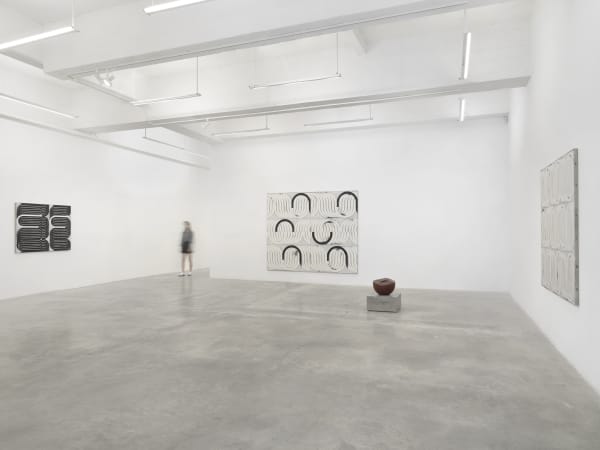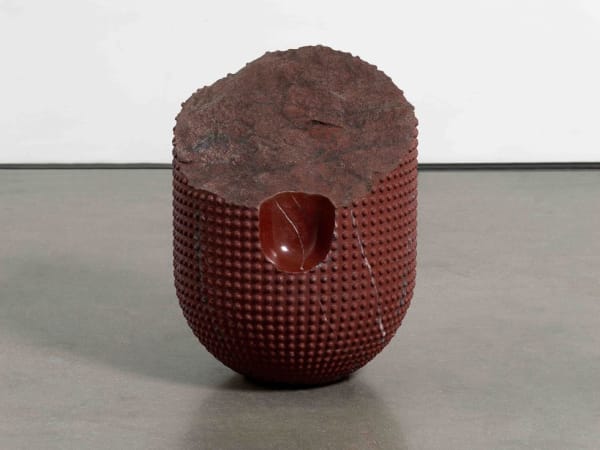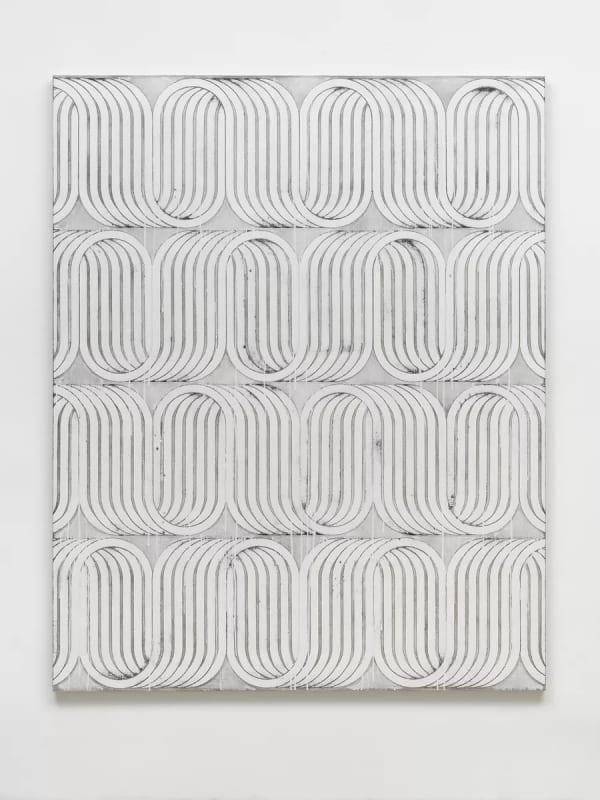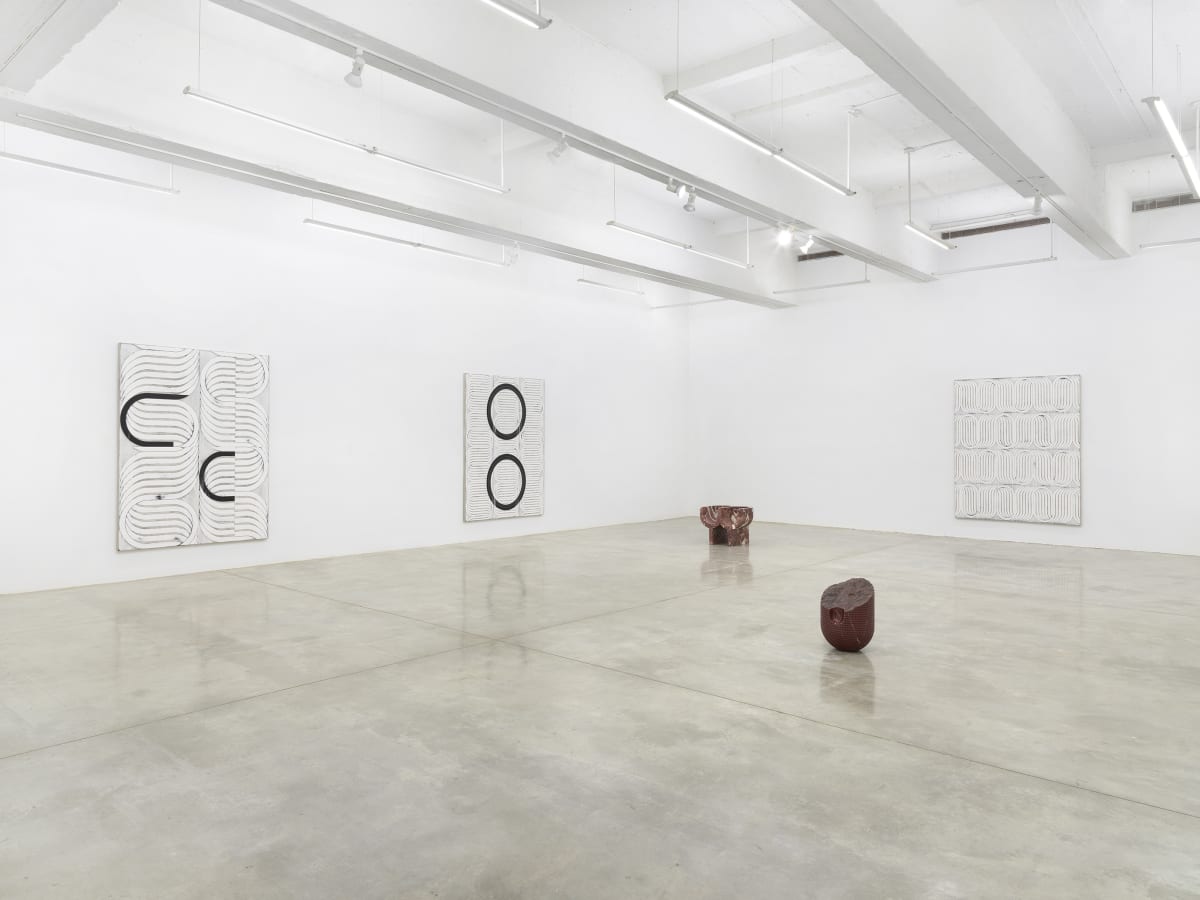Davide Balliano: Event Horizon
An event horizon is the edge of a mystery. It cuts a boundary between what can and cannot be known. And here in the interstice Davide Balliano opens novel territory in his paintings and sculptures for the flinty visual tropes he has been developing for nearly a decade. His vocabulary of images and techniques and the ideas that they encapsulate find new striking resonances across time and space. Forms that recur through the plane of paintings are also found in sculptures but in both they are ever unexpectedly terminated and hang mesmerically in a realm between apotheosis and schism.
The facture of Balliano’s paintings produces visual geology. And yet the artist’s hand appears and vanishes. [1] While the precision could be read as austere and mechanical, the works have delicate surfaces that breathe and drip. They oscillate. Even the sparest black painting, Untitled_0269, is vibrating with the fine concentric and almost monochromatic circles of its major theme and also with the diffracting marks of its small details. [2] Images like Untitled_0269 and its polar opposite, bright white Untitled_0267, are visibly conceived as snippets of a larger continuum. Their ribbony patterns repeat and are interrupted on the canvas, but their presumed extension beyond its edges is undefined. They respond to gravity. They radiate into space beyond the canvas while they drip downward toward Earth. Balliano’s rolling waves and thrumming concentric circles are sometimes interrupted by discordant breaks in an established pattern. Untitled_0247 and Untitled_0270 shatter. They change color and are bisected. (Information about where and how Balliano's paintings are strictly controlled or subject to aleatory influences—the unfurling of matte black, white, and crepuscular gray—is veiled beyond a certain limit.) Untitled_0247 wavers like a jittering transmission from deep space. His sinusoidal bands are nonetheless rescrescent. Peaks and troughs expand across the canvas and out. As with emanations across time and space and through birthing galaxies or from abandoned archaeological ruins, we can know almost nothing of them beyond their edges but that they continue. They might be imagined as diagrams of gravity waves from the early Universe. Such histories as drafted by astrophysicists are so distant and large and speculative as to be abstractions. And although Balliano's paintings might prosaically resemble the emergence of order from chaos in the Universe’s fundament by the primogenial collision of supermassive black holes, they are of themselves and are crafted by the artist alone.
Four new monolithic marble sculptures rise from the floor to greet their two-dimensional counterparts. [3] They resemble an impenetrable inhuman satellite or the displaced menhir of a forgotten neolithic civilization and their scale is more commanding than their size suggests. Their context is Balliano’s exploration of visual and dimensional form. But they speak to ages before and to come. Balliano's earlier work tended to very deep relief and into the domain of sculpture. The stones here fully inhabit that space: images in the round. The stones' material echo Balliano's painting process with their hidden but interpretable origins inside the planet. Cutting and polishing may reveal mineral facets that have not been exposed since the Earth was a primordial orb newly formed in the Universe. Their juxtaposition with the paintings may cast those latter artworks now as cultic esoterica rather than transmissions from distant worlds.
The undulating meanders of Balliano's paintings are rendered dimensional in Untitled_Rosso Agadir and Untitled_Nero Marquinia. (The sculptures are titled for the ancient names of the marble varieties.) Both use a form of two scooping U-shaped concavity. Each stands on two feet, the former on stilts and the latter standing on two mere suggestions and elevated by a concrete foundation. The paintings’ U motif is expanded into something resembling an exedra or atavistic throne. They are archaic and call to forms repeated through art’s antecedents back into ashy hominid cave paintings in prehistory. Their mineral inclusions of flowing white calcite and jet-black stylolites resemble the paintings' contingent drips and scratches. What was transformed first by the eonic processes of geology was selected and altered for the expression of something beyond the terrestrial. They are history ossified. And their refined rendering, like his careful painting, exudes tenderness.
The veins and stippling of Untitled_Rosso Laguna 1 and 2 draw closer to flesh. Ribbony geometries are supplanted by two bolluses resting on rounded bottoms. The archetypal U repeats inwardly and outwardly like a tesseract or other hyperspatial solid before the forms’ smooth and polished surfaces are unexpectedly dramatically broken. Rosso Laguna 1 is complexly layered with small beads carefully spaced in a grid across its surface. It resembles the Egyptian antiquity, Fragment of the head of a queen, even to the philtrum-like scalloping rolling down the face of the rock. And it is similarly broken off at the head. Untitled_Rosso Laguna 2 opens like a geode. Its smooth exterior is cleft to disclose a background field of sparkling rock. And within is a sanctum. It is a manmade basin as would be used in another time for anointments or holy offerings to a deity now forgotten or alien to this realm.
Davide Balliano is a summoner. He recombines simple substances into complicated images. His inquisitions are deft and increasingly focused. There are boundaries that cannot be seen past but he calls through long time and space to illuminate those borders.
- Noah Dillon
ABOUT
Davide Balliano (b.1983) is an artist whose research operates on the thin line of demarcation between painting and sculpture. Utilizing an austere, minimal language of abstract geometries in strong dialogue with architecture, his work investigates existential themes such as the identity of man in the age of technology and his relationship with the sublime. Through a practice that is self-described as monastic, austere and concrete, Balliano’s meticulous paintings appear, upon first glance, clean and precise. However, closer inspection reveals scrapes and scratches that uncover the organic wooden surface underneath the layers of paint, as a decaying façade of abandoned modernistic intentions. In addition to painting, Davide Balliano is also known for his sculptural work, which translates the visual vocabulary found in his paintings into solid objects, often in stainless steel or ceramic. Originally trained in photography, Balliano shifted to painting and sculpture in 2006 while relocating to New York City, where he currently resides and works.
Noah Dillon is an artist and writer living and working in New York.
—
[1] Balliano is happy to share how they are executed but the exacting mechanics of the process cannot fully account for their images: “I make no mystery of how my paintings are made but neither do I think that it’s required information to approach my work.”
[2] As with stars and other celestial bodies, they are given serialized, numbered titles.
[3] Unlike his serialized painting titles, the sculptures are named for the stone from which they’re carved.
-

At Davide Balliano's 'Event Horizon,' System Error is The Point
Brooklyn Magazine October 3, 2023“Event Horizon ,” the latest solo show by Brooklyn-based artist Davide Balliano at Tina Kim Gallery in Chelsea, gets its name from the surface of...Learn More -

What’s on Our Cultural Calendar This Fall
Elle Decor October 3, 2023“Event Horizon” by Davide Balliano at Tina Kim Gallery New York City Control is the word that comes most readily to mind upon entering the...Learn More -

10 Standout Gallery Exhibitions to See during Armory Week 2023
Artsy September 4, 2023With sculptures and textured paintings made of plaster, gesso, and varnish, Davide Balliano explores the boundaries of perception. “Event Horizon” features new marble works that...Learn More


